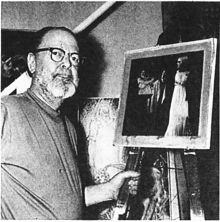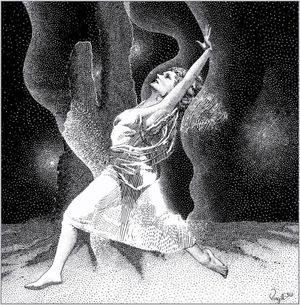Virgil Finlay
| Virgil Warden Finlay | ||
 Virgil Finlay | ||
| Background information | ||
| Birthdate: | July 23, 1914 | |
| Location: | Rochester, New York USA | |
| Notable for: | Hugo Award for Best Professional Artist, 1944 (Retro Hugo awarded in 2019), 1945 (Retro Hugo awarded in 1996); Hugo Award for Best Interior Illustrator, 1953; Science Fiction Hall of Fame, 2012 | |
| Ethnicity: | American | |
- Virgil Finlay's Women of the Ages
- By Chuck Miller
Virgil Finlay has been called "the greatest craftsman in the history of science-fiction illustration." Throughout the 1930s, '40s, and '50s, Finlay reigned supreme as the acknowledged master of fantasy, science-fiction, and horror illustration. His work appeared in the pulp magazines, the predecessors of the comics: Weird Tales, Famous Fantastic Mysteries, Startling Stories, Wonder Stories Annual, Fantastic Universe, and many others. When pulps changed format to digests he appeared in Galaxy, Amazing, Fantastic, and If.
In the 1940s Finlay did some work in the comics for DC's Real Fact Comics. These two-to-four-page features were reprinted in the early '50s in Julius Schwartz's Strange Adventures. He also did a six-page strip, "The Mad Planet," for Mystery in Space.
Finlay's imaginative and attractive illustrations appeal to many, fans. But fellow artists and art lovers marvel at his distinct, jewel-like renditions employing the painstaking stipple and crosshatching techniques of an earlier era of illustration. From his fabulous women to his horrific monsters, to scenes from legendary pasts and fantastic futures, Finlay's delicate, precise style is truly awe-inspiring.
According to Gerry de la Ree, "Finlay's black-and-white drawings were accomplished using an assortment of techniques, employing pen, brush, spatter, lithographic pencils, sponges, and knives on a variety of paper; the majority were done on scratchboard. His color work was generally done in oil thinned with quick drying siccative, and sometimes combinations of ink, watercolor, gouache, and oil.
"He refined his stipple technique throughout his career. He explained it this way: `Using a 290 lithographic pen (which has an extremely fine point), I dip the pen in India ink and allow only the liquid to touch the drawing surface, which is normally scratchboard. The point is then wiped clean and re-dipped for the next dot.' Obviously, this was a time-consuming operation."
Finlay's career paralleled the emergence of the grand masters of the field. He illustrated stories by Robert E. Howard, H.P. Lovecraft, Robert A. Heinlein, A. Merritt, Isaac Asimov, Andre Norton, Clark Ashton Smith, Seabury Quinn, Edgar Rice Burroughs, L. Ron Hubbard, Arthur C. Clarke, C.L. Moore, Henry Kuttner, Robert Bloch, L. Sprague de Camp, Jack Vance, and many others.
He illustrated several books which have become classics, including the wonderful Christmas tale Roads by Seabury Quinn, The Ship of Ishtar by A. Merritt, and a rare 1935 paperback edition of Shakespeare's A Midsummer Night's Dream. Perhaps most well known is his black-and-white dustjacket illustration for The Outsider and Others by H.P. Lovecraft in 1939, the first Arkham House title published.
From 1938 to 1951, Finlay produced more than 800 drawings and covers for The American Weekly newspaper supplement edited by A. Merritt and published by William Randolph Hearst. Because of the increased pay scale he was able to devote vast lengths of time to this work, and it is considered some of his best work. A bound portfolio of 24 drawings from The American Weekly was published in 1977 by Tim Underwood and Russ Swanson.
Throughout the years other books and collections of Finlay's art have appeared. Famous Fantastic Mysteries issued three portfolios of his work in the 1940s. In the 1950s and 1970s other portfolios were produced by Robert Weinberg and others. Donald M. Grant published two volumes of his work in the 1970s and between 1975 and 1981, Finlay collector extra ordinaire Gerry de la Ree issued several portfolios and seven hardcover volumes of Finlay's work. Today, these books are much in demand and difficult to obtain.
Finlay died of cancer in early 1971, but his work is fondly remembered and extremely collectible. Original black-and-white illustrations often sell for more than $1000 and color paintings, especially from famous Weird Tales covers, are rarely offered for sale.
Virgil Finlay's Women of the Ages collects the best of his illustrations depicting women from the distant past to the far future. This volume is published by Underwood-Miller with the cooperation of Lail Finlay Hernandez, Virgil's daughter, and the generous help of Gerry de la Ree. Robert Weinberg also lent his assistance and the color cover reproduces a stunning painting in the collection of Steve Korshak.
(Source: Comics Buyer's Guide #972 - July 3, 1992)
Chat rooms • What links here • Copyright info • Contact information • Category:Root
